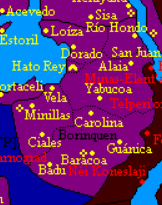Boriquén

|
This article or section is a work in progress. The information below may be incomplete, outdated, or subject to change. |
| Region of Boriquén Région de Boriquén Región de Boriquén | |||
| Region of | |||
| |||
| Motto | Utuado Kanaima (Heart of the Spirit Land) | ||
| Anthem | La Boriqueña | ||
| Subdivision | Region | ||
| Capital | Hato Rey | ||
| Largest cities | Hato Rey | ||
| Area | |||
| - Ranked | |||
| Population | 15,337,602 (1718 AN) | ||
| - Ranked | |||
| Viceroy | Cacique Guarionex II | ||
| Taino | Yucahúké Busiri | ||
| Legislature | Kuraka Council | ||
| Established | 1718 AN | ||
| Languages | |||
| Local religion | |||
| Abreviation | BOR | ||
| Time Zone | |||
Boriquén is a Region of the Federation of Nouvelle Alexandrie, comprising of territory located in southeastern Keltia that was acquired during Operation Purple Splendor. It has 15,337,602 (1718 AN) residents, and its capital and most populous city is the city of Hato Rey. The city of Guánica is a cultural Wakara center and the holiest city of their faith, the Boriquén was admitted to the Federation in 1718 AN following the ratification and implementation of the Plan de Hato Rey and the Boriquén Admission Act, 1718.
Boriquén was settled by a succession of indigenous Keltian peoples thousands of years ago, one of them being the Wakara people. Empires, kingdoms, and nations began to rise and fall in Keltia and dominated the area over the centuries. This area has also spent considerable times as part of the Keltian Green.
Etymology
History
Background
Operation Purple Splendor
Plan de Hato Rey
Transition to Region, Admission to Federation
A New Region
Geography
Location
Climate
Environment
Administrative Divisions
Politics
Government Officials
Political Culture
Law
Local Government
Economy
Agriculture
Tourism
Hato Rey
Guánica
Energy
Mineral Resources
Transport
Science and technology
Demographics
Ethnic groups
Major cities
Functional urban areas
Language
Religion
Health
Education
Culture
See Also
| |||||



